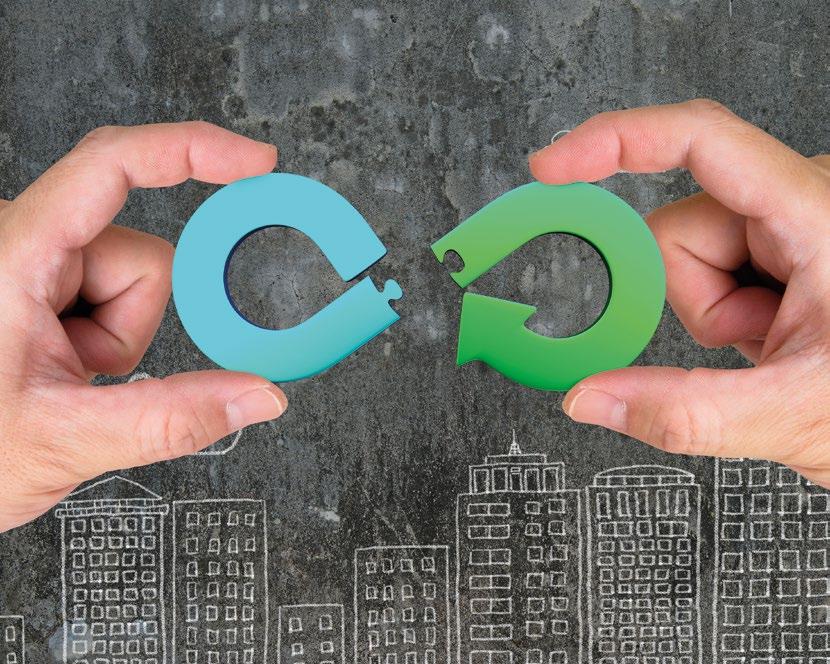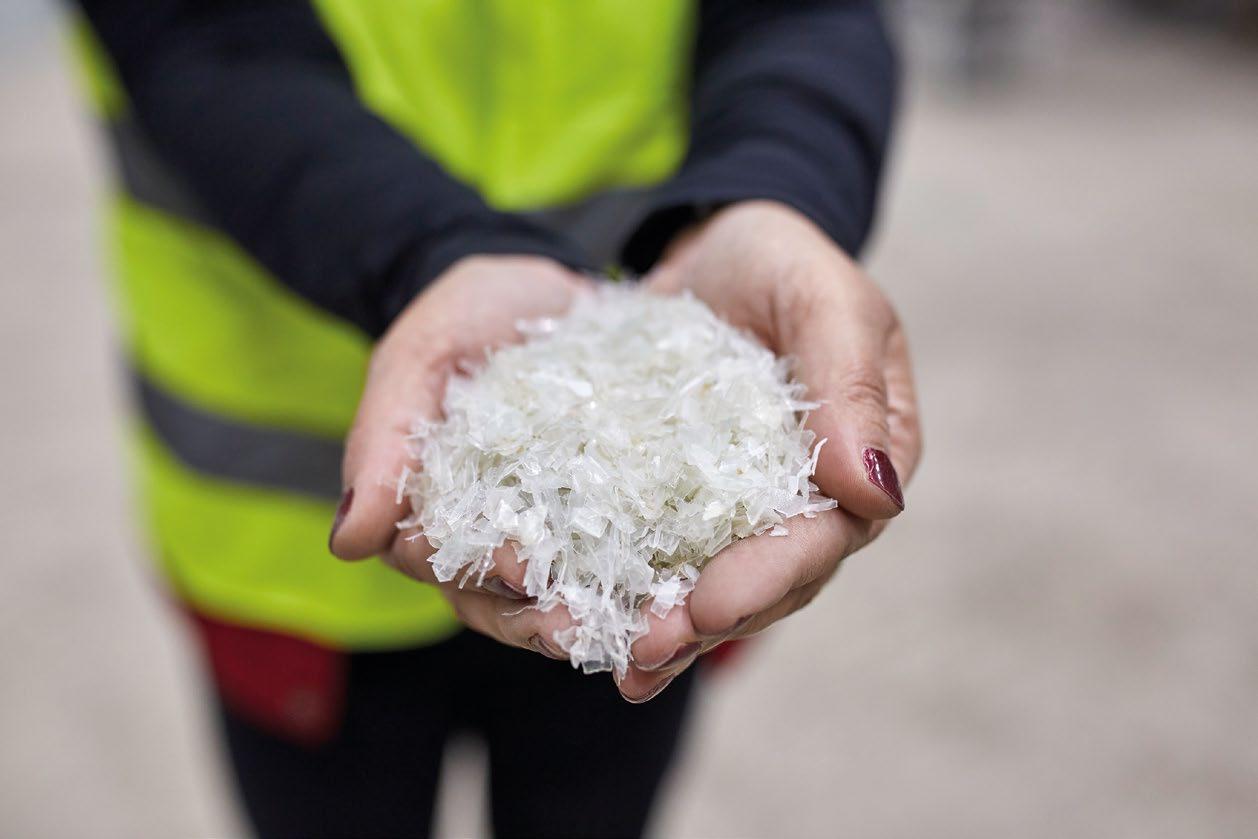
6 minute read
THE CIRCULAR ECONOMY IN 2021
The value chain will continue to progress on design for recycling this year – but needs to continue to build cross-industry alignment and will look to regulators to provide a supportive landscape. Tim Sykes surveys the key points on the circularity agenda this year.
THE CIRCULAR ECONOMY IN 2021
Though we all found ourselves grappling with the challenges of COVID, last year was a busy one in the march toward a circular economy in Europe. The Circular Economy Action Plan 2.0 was published by the European Commission in March 2020, as a cornerstone of the European Green Deal. In parallel we saw more and more packaging designed for recycling in traditionally hard-to-recycle formats and applications. In the crucial arena of flexibles the CEFLEX consortium published its landmark ‘Designing for a Circular Economy’ guidelines in June. Meanwhile, industry extended the functional boundaries of recyclable packaging with a series of product launches, from mono-polyolefin films tackling increasingly challenging applications to barrier papers.
So what advances should we anticipate in 2021 – and what are the challenges and dilemmas we need to confront?
Flexibles
CEFLEX will be working holistically as ever across its workstreams to fill knowledge gaps and identify solutions to the technological, investment case and viability challenges around a circular economy in flexibles. The project is increasingly moving from ‘think tank to act tank’ with a focus shift from theory to implementation.
We can expect, for example, to discover the important conclusions of compositional analysis work aimed at understanding first-hand which waste streams flexible packaging is collected in, along with the types and quantities involved. This work (the product of collaboration with PCEP, Petcore, Styrenics Circular Solutions and More Recycling) will provide a detailed understanding of waste streams which will be crucial in aligning recycle-ready packaging materials with end of life outcomes.
Innovation will be a no less crucial part of the equation. “High potential technologies are breaking through,” CEFLEX project coordinator Graham Houlder commented. “We’ve had the launch of HolyGrail 2.0, and CEFLEX teams are making good progress on assessing the opportunities around chemical recycling and supporting delamination and separation pioneers. These technical innovations can, and will, develop promising new solutions that enable better quality and greater quantities of recycled materials to service new end markets. One realization that crystallized during 2020 is that the circular economy for plastics is not possible without chemical recycling so we all need to support its recognition and commercialization as soon as possible.”
Meanwhile, stakeholders in CEFLEX such as Amcor, Mondi and Taghleef Industries are focusing on adding to the portfolio of designed-for-recycling packaging solutions. Having made several prominent launches within the food category last year, Amcor’s R&D pipeline features solutions aimed at the even more challenging healthcare segment. Mondi will be continuing its focus on circularity, with more customers trialling recyclable films, and contributing the all-important market pull by increasing recycled content in packaging. Taghleef is launching its 360° reDESIGN approach: a tailor-fit service solution which aims to lead the switch from traditional packaging structures to more sustainable and innovative solutions, across all product families.
Paper
While flexible plastics are collectively shifting to polyolefin-based monomaterials, it’s notable that the FMCG world is also investing significantly in the ‘paper where possible’ ethos. November 2020 saw the launch of the 4evergreen alliance by CEPI. This in many respects is the paper value chain’s analogue to CEFLEX: it aims to develop design for circularity guidelines for fibre-based packaging; establish industry-wide recyclability evaluation protocols; publish guidelines for improved collection and sorting across Europe; and drive innovations in areas increasing circularity.
Indeed, 4evergreen features significant membership crossover with CEFLEX, not only among the brand owner stakeholders, but also packaging producers. Given the fresh experience of many of the same organizations in serious and
The advanced mechanical recycling demo plant in Lahnstein will produce high-purity solutions suitable for demanding packaging applications.

wide collaboration around flexible plastics, it can be expected that proactive and rigorous work will be channelled into the alliance’s headline goal of taking the circularity of fibre-based packaging to 90% by 2030. Meanwhile, not only dedicated paper businesses, but also material-agnostic packaging companies will be investing R&D resources into developing a portfolio for a growing space in the circular packaging market. For instance, as part of Amcor’s ongoing focus on recyclability we can expect product launches in recyclable functional/ barrier packaging paper, while Mondi is also leveraging its expertise in paper manufacturing to develop alternatives to plastics in certain applications.
Turning the supertanker
For all of the industry’s cumulative collaborative and unilateral efforts, there is a widespread view that one of the most important items of the 2021 agenda is ensuring that the wider world is equipped to embrace a circular economy.
End of life technology is increasingly demonstrating that recycled feedstocks can meet the demanding specifications of packaging. For example, a new state-of-the-art demo plant was recently opened by Borealis and TOMRA in Lahnstein, which will process rigid and flexible plastic household waste, producing high-purity, low-odour outputs with high product consistency, enabling brand owners and converters to qualify and validate PCR for their applications. The hope is that that the technical success of this venture will lay the groundwork for a commercial-scale advanced recycling plant – but across the Europe the transition from technical possibility to scaled up capacity relies on a favourable market.
“We now know the design for recycling guidelines, but the recycling infrastructure has to develop,” said Gerald Rebitzer, sustainability director at Amcor Flexibles. “For flexible household packaging we need to increase from around 500,000 or 600,000 tonnes recycling capacity currently to 4.5 million tonnes. Mono-polyolefin based packaging is likely to be recycled in a handful of European countries but not in others. The challenge is to create incentives for the waste management sector to invest. It’s above all down to EPR schemes and legislators to take this forward. Italy, for example, has introduced a ‘stream in development’ category with a lower EPR fee. So at this stage the ball is not only in industry’s court. We know what we need to do and understand our responsibilities – and our actions need to be reflected in policy and infrastructure.”
Mondi’s Graeme Smith (head of product sustainability, Flexible Packaging and Engineered Materials) similarly emphasises the importance of regulatory support on this year’s circular economy agenda. “Getting extended producer responsibility and eco-modulation right will be critical in ensuring easier to recycle packaging has a lower burden,” he commented. “There’s a need for harmonized legislation to support this.”
Looking at regulation on a more macro level, 2021 will be a critical year in shaping the future of sustainability in packaging. “The upcoming review of the Packaging and Packaging Waste Directive can represent a real milestone in the process of moving towards a sustainable packaging value chain in Europe,” Francesca Stevens, managing director of EUROPEN, told Packaging Europe. “This requires strengthening the regulatory framework and make sure that it is future-proof. This is key to enabling the uptake and growth of sustainable packaging systems, as part of a wider transition towards a circular and climate neutral economy. The systemic changes required to support this transition, for example with regards to waste management infrastructure and commercial distribution models, should also be factored in.”
She continued: “The scale of the Single Market and the certainty of free movement of goods are essential to underpin the major investments in technology and product innovation needed to transition to a circular economy. However, the integrity of the Single Market is increasingly threatened by uneven transposition of EU laws and a growing patchwork of disparate national rules that hinder the free movement of packaging and packaged goods and risk inhibiting investments in innovation.”
No one expects the tangled trade-offs of balancing multiple regulatory objectives to be perfected in the coming year. Even so, evidence that the EU supertanker is turning in the right direction with regard to cultivating confidence to invest in a circular economy will be one of the most significant developments of 2021, and a conversation which every one of us should participate in. n











